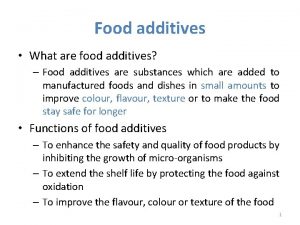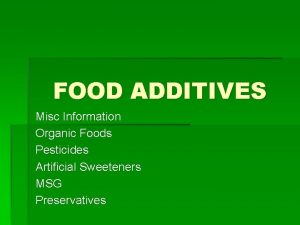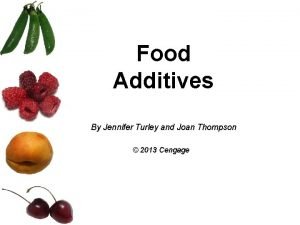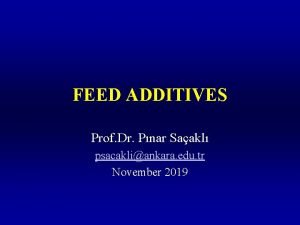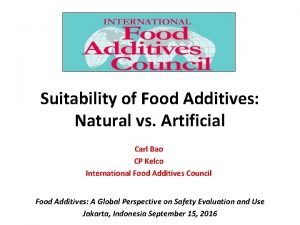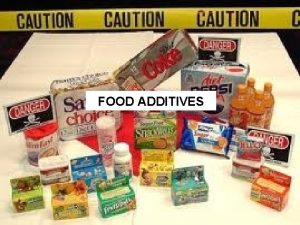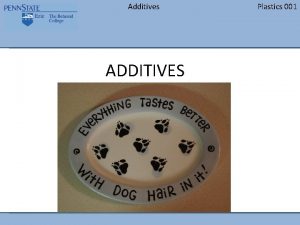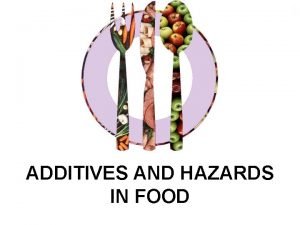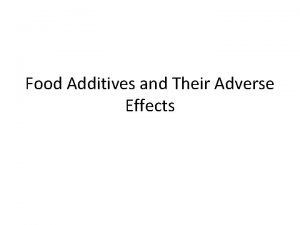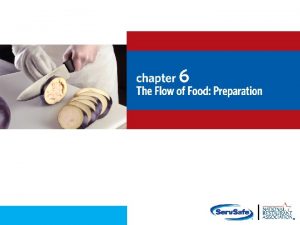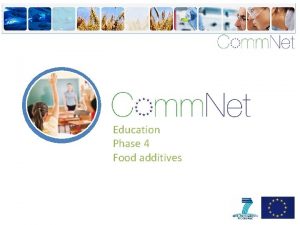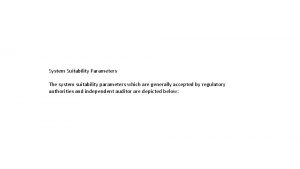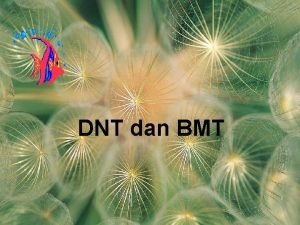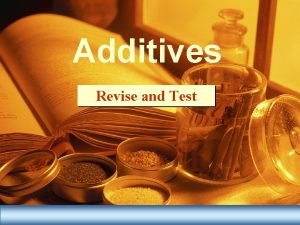Suitability of Food Additives Natural vs Artificial Aliah

Suitability of Food Additives: Natural vs. Artificial Aliah Wahab Chr. Hansen International Food Additives Council Food Additives: A Global Perspective on Safety Evaluation and Use Hanoi, Vietnam September 13, 2016

Presentation Overview • • • Food Additive Safety & Suitability Benefits of Food Additives Self-Limiting Properties of Food Additives Food Additive GMPs and IFAC GMP Guide Misconceptions about Food Additives – Chemophobia and the Role of the Media – Role of Regulators and Industry • Conclusion

Safety of Food Additives Food additives are thoroughly studied, including extensive toxicological testing, before they are approved for use in food Testing includes short-term and long-term toxicity studies, including carcinogenicity studies with a built in safety factor to account for uncertainties U. S. FDA “Guidance for Industry and Other Stakeholders: Toxicological Principles for the Safety Assessment of Food Ingredients” (Redbook) Food additive identity, purity and quality is provided through adherence to specifications, which are developed prior to use in food Food additives have been used safely for decades

Suitability of Food Additives Food additives afford consumers added convenience and enjoyment of a wide variety of appetizing and nutritious foods and beverages Food additives are critical to the safety and nutritional composition of many foods and beverages Food additives used for technical purposes in finished foods and beverages fall into four main categories: • Support nutrition delivery • Maintenance of food quality and freshness • Processing and preparation aids • Enhanced appeal

Food Additives Help Feed the World Global Population Growth: • 7 billion in 2010 • 9+ billion by 2050 That means there will be 75 million more people to feed each year Almost 1 billion people do not have enough food today One solution to ensure food safety, maintain affordability, extend shelf-life, simplify preparation and minimize waste

Food Additives Have Many Technological Functions in Foods Codex International Numbering System (INS) lists 23 functional classes for food additives The INS is hierarchical in that each of the 23 functional classes has sub-classes with additional functions • Ex. , functional classes include acidity regulator, anticaking agent, coloring, emulsifier, flavor enhancer, gelling agent, stabilizer and thickener • Ex. , sub-classes under “anticaking agent” include antistick agent, drying agent, dusting powder and release agent

Food Additives are Self-Limiting • Inherent properties of food additives like taste or technological functions limit the amount that can be added to foods – Too much of an additive can result in undesirable effects or off-taste – Example: using a high level of a particular food gum in salad dressing production causes the product to become viscous, thick and undesirable • For these reasons, manufacturers use no more of any food additive than absolutely necessary to achieve a desired technical effect

Good Manufacturing Practices for Food Additives and GRAS Substances Good Manufacturing Practices (GMPs) help ensure the safety and quality of foods and beverages Hazard Analysis and Critical Control Point (HACCP) plans, including GMPs, are required through U. S. Food Safety Modernization Act General practice is the lowest level of a particular food additive necessary to achieve the intended technological function should be used in a food or beverage The food additive industry is significantly different than the food industry (e. g. , production, packaging, etc. ) Food additives undergo further downstream processing by customers/manufacturers GMPs for finished foods are therefore not necessarily relevant to food additives

IFAC GMP and Audit Guides for Food Additives and GRAS Substances • Represent voluntary guidance for food ingredient industry • Provide GMP and quality assurance principles to ensure safe manufacture of food additives and GRAS substances • Being updated to incorporate concepts/requirements in FDA Food Safety Modernization Act requirements • May be used to aid in FSMA compliance for domestic and foreign suppliers • Guides developed by IFAC Food Safety Committee Ø Ø Ø Ashland Chr. Hansen Colorcon CP Kelco Du. Pont FMC Corporation Ø Ø Ø ICL Food Specialties Innophos Kerry Ingredients & Flavours Pinova Prayon

IFAC GMP and Audit Guides Copies available at http: //foodingredientfacts. org/aboutus/resources/ifac-resources/

Safety & Suitability of Food Additives Natural vs. Artificial

Natural vs. Artificial • Emerging trend that consumers are afraid of ingredients in foods and beverages due to the perception that they are “unnatural, ” unnecessary or unhealthy = Chemophobia • Consumers now more than ever want to know what’s in their food • Consumers are increasingly pushing for “clean” labels • However, most consumers have a fundamental misunderstanding of the role of food additives: Ø Do not understand safety evaluations Ø Do not understand benefits Ø Do not understand food additive names

Misunderstandings of Safety • “Natural” ingredients and food itself (i. e. , grain, meat, vegetables) are “substances” comprised of chemicals • Most consumers don’t realize common substances are in fact chemicals (ex. , Na. Cl = salt) • Food additives are “substances” too • “Natural” ingredients are no more inherently safe than food additives • Many natural ingredients can be toxic and harmful: Ø Just because something is “natural” doesn’t mean it is inherently safe Ø Just because something is “synthetic” doesn’t make it inherently unsafe

Example: Ascorbic Acid vs. Vitamin C Vs.

Example: Ingredient List of a Banana

Chemophobia perpetuated by the media and food companies • White. Wave pulling carrageenan from Silk, Horizon milk products (Aug 2014) • Chipotle goes non-GMO, and embarks on ‘quest to eliminate additives’ (Apr 2015) • Panera unveils long ‘no no’ list of over 150 banned ingredients (May 2015) • Pizza Hut, Taco Bell to remove artificial colors, flavors from foods (May 2015) • Subway to remove all artificial flavors, colors and preservatives from North American menu (June 2015) • General Mills to remove artificial flavors and colors (June 2015)

Role of Regulators and Industry • Collaborate on the development of food additive standards and specifications that are based on sound science and globally harmonized. • Maintain food additive standards that are based on technological need/function. • Educate consumers about the safety of food additives. • Provide simple, clear messages about the role food additives play and their necessity for a safe and stable food supply. Ø Food. Ingredient. Facts. org

IFAC’s Ongoing Efforts

Conclusion • Additives have a long history of safe use and provide benefits to food processors and consumers; will help address future food supply challenges. • Food additives have unique GMPs and should be produced accordingly. • Misconceptions about chemicals in food and preference for “natural” are driving consumer concerns about food additives. • All foods contain chemicals; “natural” is not always better. • Both industry and government have a role in helping to better inform all stakeholders about food additives and the modern food system.

Helpful URLs • IFAC website – foodingredientfacts. org • Codex INS List – www. codexalimentarius. org/download/standards/11341/CXG_03 6 e_2015. pdf • FDA Redbook – http: //www. fda. gov/Food/Guidance. Regulation/Guidance. Docume nts. Regulatory. Information/ucm 2006826. htm • IFAC GMP Guides – http: //foodingredientfacts. org/knowledgecenter/food-regulation/

Questions? Thank you! Aliah Wahab Regional Regulatory Affairs Director APAC CHR. Hansen Singapore Pte Ltd. SGAAW@chr-hansen. com International Food Additives Council 750 National Press Building Washington, DC USA foodingredientfacts. org
- Slides: 21

